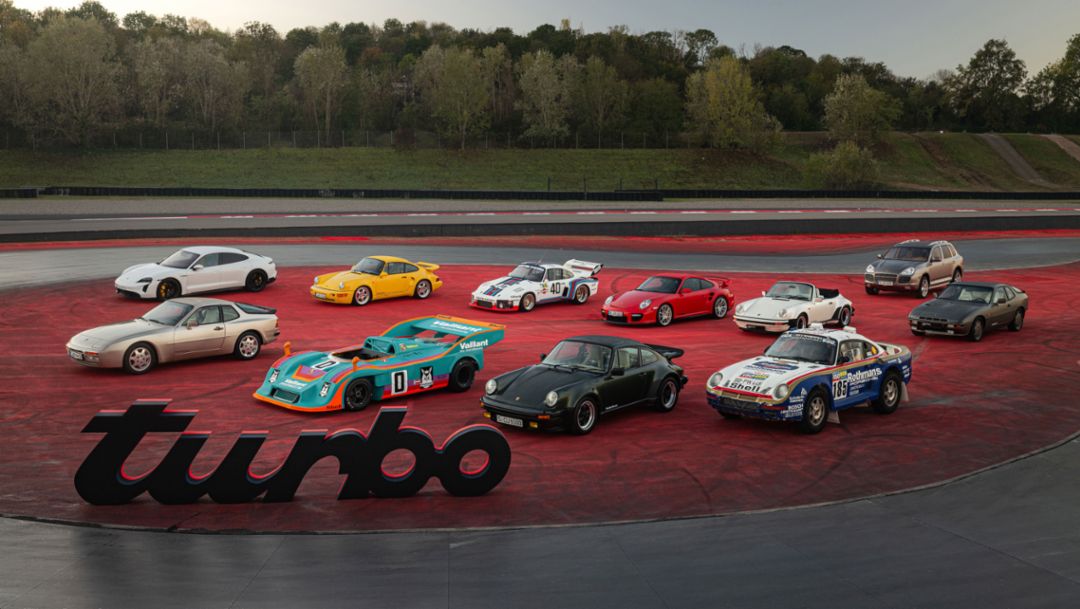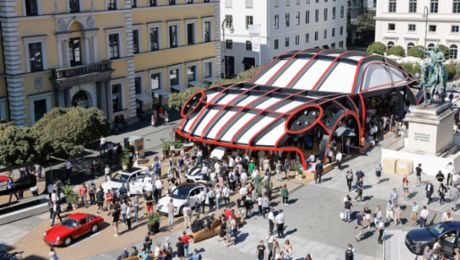An exhibition dedicated to 50 years of Turbo at Zhejiang International Circuit, in Shaoxing, China, has brought together remarkable cars, notable engines and iconic Turbo themes in one thrilling display. Porsche China organised for a Porsche 911 Turbo (930), Porsche 959 Paris-Dakar and a limited-edition 911 Turbo S anniversary model to be displayed alongside a trio of historic Turbo engines that have played a significant role in Porsche history.
The Turbo principle marks the boundary of what is feasible at Porsche. A Turbo from Zuffenhausen is the pinnacle of its model line. It combines experience and success, performance and everyday usability. Every Turbo carries within it all the victories that Porsche has celebrated on the racing tracks of the world. And while a Turbo dynamically connects the driver with the road, they in turn feel even more connected with the car. Turbo means a history that goes back more than 50 years to its motorsport roots. But it’s never just about the pure power of a Turbo, but much more about the Turbo feeling. The feeling of always going beyond the ordinary. The feeling of ‘more’.
From the racetrack to the road car
The 911 Turbo (930) – the first Porsche model to bear the Turbo name – was one of the fastest cars of its time and is instantly recognisable thanks to its wider wheel arch extensions, tyres and tracks and the iconic ‘Tea Tray’ spoiler at the rear. The cutting-edge Porsche 959 Paris-Dakar entered the history books when it mastered the gruelling Paris-Dakar Rally in 1986, racing thousands of kilometres from France to the deserts and savannahs of Africa. And the Gold Bronze Metallic Porsche 911 Turbo S anniversary model, which was limited to just 10 units worldwide, was released to mark 10 years of Porsche China in 2011.
Among the engines to feature in the exhibition was the 1.5-litre V6 twin-turbocharged TAG Turbo F1 engine, designed by Porsche at the request of the McLaren Formula One team, which would go on to power McLaren to five championship wins between 1984 and 1986. Also on display was the 2.0-litre V4 turbocharged engine from the triple-Le Mans-winning Porsche 919 Hybrid. At the heart of the hybrid racing car, this engine worked with an innovative turbine generator, effectively charging the 800V lithium-ion battery and providing a continuous power boost to the electric motor, maximising efficiency and contributing significantly to its success at Le Mans. The 800V system would go on to become a core element of Porsche’s all-electric cars. Finally, a 3.3-litre, air-cooled, turbocharged boxer engine from the Porsche 911 Turbo (930) also formed part of the exhibition.
Tartan and Turbonite
Hero cars and engines aside, tartan and Turbonite featured heavily in the display. The former became closely linked to the Porsche Turbo after ‘Black Watch’ tartan first appeared on the seat centres and side bolsters of the 911 RSR Turbo concept car in 1973. Together with ‘McLaughlin’ tartan, which featured on the seat centres of the 911 Turbo ‘No. 1’ that was given to Louise Piëch on her 70th birthday the following year, and the beige, red, blue, white and olive green of ‘Mackenzie’ tartan, ‘Black Watch’ has become part of Porsche’s enduring association with the historic Scottish pattern.
With the evolution of Turbo culture, Porsche developed Turbonite – a timeless and elegant shade of grey that is exclusive to Turbo models today – and this too featured in the exhibition. Gold-tinted elements create the eye-catching, metallic effect of Turbonite, while the top layer of the paint has a contrasting satin-matte finish. On Porsche Turbo derivatives across all model lines, the lettering on the rear, the Porsche crest and the borders of the side windows are all finished in this special colour, while accents throughout the interior and exterior emphasise a Turbo’s flagship status.


